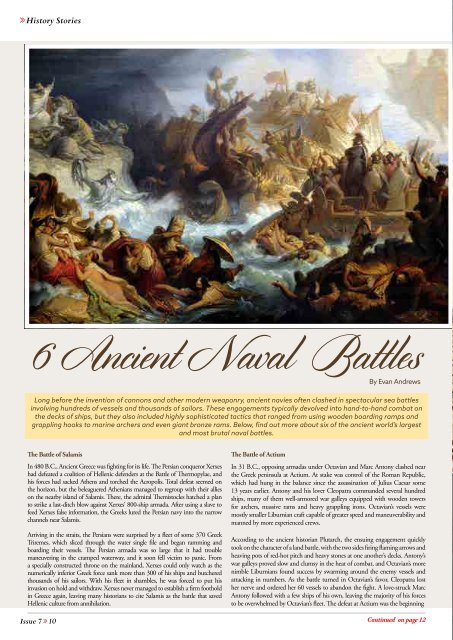You also want an ePaper? Increase the reach of your titles
YUMPU automatically turns print PDFs into web optimized ePapers that Google loves.
History Stories<br />
6 Ancient Naval Battles<br />
By Evan Andrews<br />
Long before the invention of cannons and other modern weaponry, ancient navies often clashed in spectacular sea battles<br />
involving hundreds of vessels and thousands of sailors. These engagements typically devolved into hand-to-hand combat on<br />
the decks of ships, but they also included highly sophisticated tactics that ranged from using wooden boarding ramps and<br />
grappling hooks to marine archers and even giant bronze rams. Below, find out more about six of the ancient world’s largest<br />
and most brutal naval battles.<br />
The Battle of Salamis<br />
In 480 B.C., Ancient Greece was fighting for its life. The Persian conqueror Xerxes<br />
had defeated a coalition of Hellenic defenders at the Battle of Thermopylae, and<br />
his forces had sacked Athens and torched the Acropolis. Total defeat seemed on<br />
the horizon, but the beleaguered Athenians managed to regroup with their allies<br />
on the nearby island of Salamis. There, the admiral Themistocles hatched a plan<br />
to strike a last-ditch blow against Xerxes’ 800-ship armada. After using a slave to<br />
feed Xerxes false information, the Greeks lured the Persian navy into the narrow<br />
channels near Salamis.<br />
Arriving in the straits, the Persians were surprised by a fleet of some 370 Greek<br />
Triremes, which sliced through the water single file and began ramming and<br />
boarding their vessels. The Persian armada was so large that it had trouble<br />
maneuvering in the cramped waterway, and it soon fell victim to panic. From<br />
a specially constructed throne on the mainland, Xerxes could only watch as the<br />
numerically inferior Greek force sank more than 300 of his ships and butchered<br />
thousands of his sailors. With his fleet in shambles, he was forced to put his<br />
invasion on hold and withdraw. Xerxes never managed to establish a firm foothold<br />
in Greece again, leaving many historians to cite Salamis as the battle that saved<br />
Hellenic culture from annihilation.<br />
Issue 7 >> 10<br />
The Battle of Actium<br />
In 31 B.C., opposing armadas under Octavian and Marc Antony clashed near<br />
the Greek peninsula at Actium. At stake was control of the Roman Republic,<br />
which had hung in the balance since the assassination of Julius Caesar some<br />
13 years earlier. Antony and his lover Cleopatra commanded several hundred<br />
ships, many of them well-armored war galleys equipped with wooden towers<br />
for archers, massive rams and heavy grappling irons. Octavian’s vessels were<br />
mostly smaller Liburnian craft capable of greater speed and maneuverability and<br />
manned by more experienced crews.<br />
According to the ancient historian Plutarch, the ensuing engagement quickly<br />
took on the character of a land battle, with the two sides firing flaming arrows and<br />
heaving pots of red-hot pitch and heavy stones at one another’s decks. Antony’s<br />
war galleys proved slow and clumsy in the heat of combat, and Octavian’s more<br />
nimble Liburnians found success by swarming around the enemy vessels and<br />
attacking in numbers. As the battle turned in Octavian’s favor, Cleopatra lost<br />
her nerve and ordered her 60 vessels to abandon the fight. A love-struck Marc<br />
Antony followed with a few ships of his own, leaving the majority of his forces<br />
to be overwhelmed by Octavian’s fleet. The defeat at Actium was the beginning<br />
Continued on page 12

















